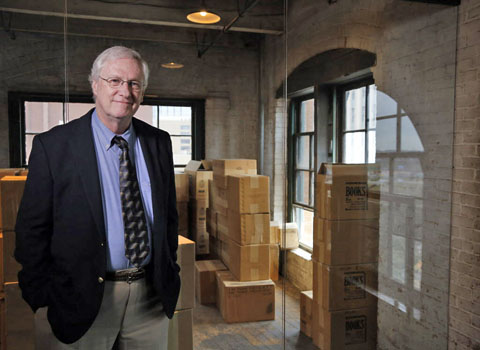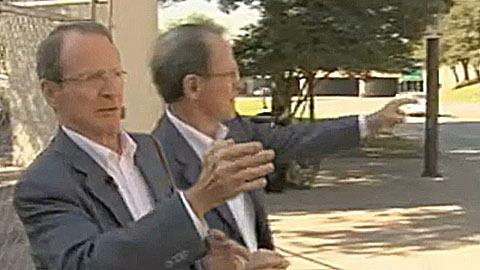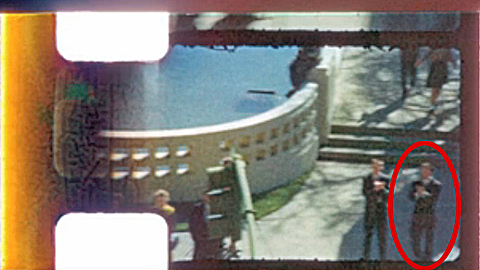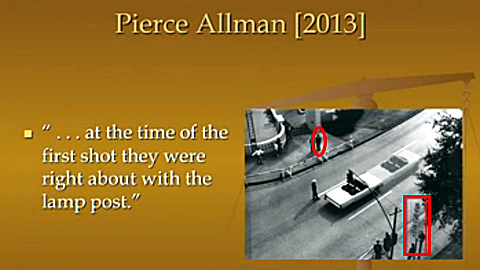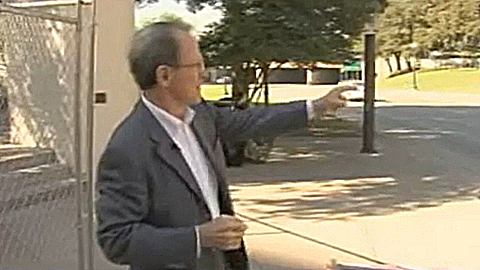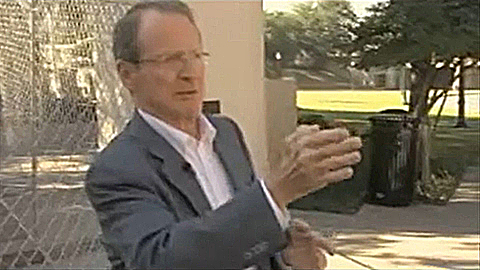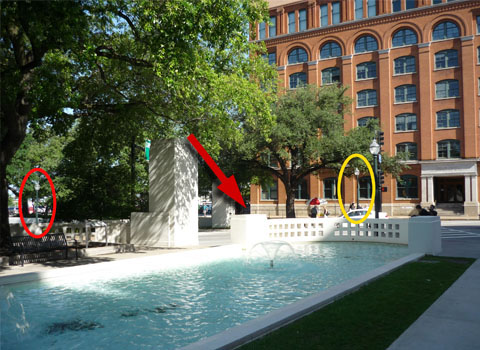by DALE K. MYERS
The respected father-and-son forensic team of Luke and Michael Haag has been debunking popular conspiracy theories surrounding the JFK assassination for the better part of two years using 3D laser scanners, Doppler radar, and other high-end forensic equipment.
In 2013, the duo hit the national stage when they used the latest technology to re-examine the idea that one bullet hit President John F. Kennedy and Texas Governor John Connally for the PBS series Nova in a documentary called “Cold Case: JFK.”
In the year and a half since that broadcast, these two forensic scientists have continued to add to our knowledge of the assassination case with a high level of expertise.
The father-and-son team
Lucien C. “Luke” Haag has had more than 100 peer reviewed articles published since 1974 in The AFTE Journal, the official publication of The Association of Firearm and Tool Mark Examiners.
Here’s a small sample of some of the titles:
- “Bullet Ricochet: An Imperical Study and a Device For Measuring Ricochet Angle” (1975)
- “The Use of Ballistic Calculations in the Solution of a Crime” (1976)
- “The Forensic Use of Exterior Ballistic Calculations” (1979)
- “A Preliminary Inquiry into the Application of Sound Spectography to the Characterizations of Gunshots” (1979)
- “The Measurement of Bullet Deflection by Intervening Objects and the Study of Bullet Behavior After Impact” (1987)
- “Bullet Penetration and Perforation of Sheet Metal” (1997)
- “The Sound of Bullets” (2002)
- “Sequence of Shots Through Tempered Glass” (2004)
- “Muzzle Flash: One Witness Sees It, the Other Does Not” (2007)
- “Firearms Sound Levels and Measurements: An Impulse Sound Control Source for dB Measurements of Gunshots Parts 1 & 2” (2009)
- “The Exterior Ballistic Performance of Ricocheted and Destabilized Bullets” (2013)
- “The Production and Persistence of Gunpowder Tattooing and Stippling of Living Human Skin” (2014)
- “Bullet Entry Holes in Fabric: Fibers, Facts, and Fallacies” (2014)
Luke’s son, Michael G. Haag, has also established himself as one of the southwest’s leading forensic experts covering a wide-range of related subjects including firearms and tool mark identification; firearm design, operability, defects, alterations, conversions and modifications; cartridge manufacture; external and terminal ballistic calculations and determinations; gunshot residue deposits; and more.
A forensic investigative series
Beginning in the spring of 2014, The AFTE Journal published three outstanding articles detailing Luke and Michael Haag’s investigation into the forensic aspects of the JFK murder.
The first in the series, “Tracking the ‘Magic’ Bullet in the JFK Assassination” (2014 Volume 46, Number 2, Spring, pages 104 thru 113) took readers through a step-by-step analysis of the so-called ‘magic’ bullet, its seemingly amazing journey and an evaluation and interpretation of its physical condition with the end result that there is nothing magic about the ‘magic’ bullet once one acquires an understanding of this novel bullet’s exterior, terminal and wound ballistic properties.
The second in the series, “President Kennedy’s Fatal Gunshot Wound and the Seemingly Anomalous Behavior of the Fatal Bullet” (2014 Volume 46, Number 3, Summer, pages 218 thru 223) examined the differences between the two wounds suffered by President Kennedy – the non-fatal neck wound and the fatal headshot. Haag points out that the Western Cartridge Company 6.5mm Carcano bullet that produced Kennedy’s second and fatal gunshot wound exhibited very different wound ballistic behavior than the WCC full metal-jacketed 6.5mm Carcano bullet that produced his first gunshot wound. This perforating wound through the President’s upper right back left no bullet fragments along its nominal 6-inch wound track and left a small, round exit wound in his throat. In contrast, the subsequent fatal head wound produced massive disruption of the President’s brain and skull along with fragmentation of the bullet. This article explains the seemingly contradictory behavior of the very unusual and uncommon 6.5mm Carcano bullets involved in this historic case.
The third in the series, “President Kennedy’s Fatal Head Wound and his Rearward Head ‘Snap’ ” (2014 Volume 46, Number 4, Fall, pages 279 thru 289) offered an explanation based on the laws of physics for the abrupt, rearward movement of President Kennedy’s head in the fractions of a second after he sustained his fatal head wound. While there may be other factors involved or explanations for the rearward head ‘snap’, a frontal gunshot wound proposed by a number of conspiracy advocates is not one of them.
All three of these articles are sobering, instructive, and a must read for anyone interested in the science behind bullet ballistics and in particular, the JFK case.
The latest installment
This time, the Haag team tackles the shot that missed the President. Ballistic evidence clearly supports the proposition that Oswald fired three shots from the sixth floor, southeast corner window of the Texas School Book Depository building with his 91/38 6.5mm Carcano rifle. Two of these three shots struck President Kennedy. The bullet from one of these two shots also struck Texas Governor Connally.
Unaccounted for is the fate of the bullet from the missed shot, its order in the three shot sequence and its flight path. This outstanding article presents a step-by-step forensic review and analysis of the assassination, as well as the exterior and terminal ballistics of the 160-grain 6.5mm WCC Carcano ammunition.
The Haag team’s conclusion? The missing shot was the first shot fired and self-destructed when it struck the asphalt of Elm Street at a relatively steep angle.
Luke Haag not only builds a solid, scientific case for these conclusions, but forensically destroys the theory that the first shot ricocheted off the traffic mast pole at Elm and Houston and went on to superficially wound bystander James Tague – a theory proposed by writer Max Holland and which has gotten considerable mainstream attention over the past seven years despite being debunked again and again on the pages of this blog.
And no, I don’t believe for a minute that the debate over this issue will come to an end in the wake of Haag’s lucid and expert analysis. For some people, headlines (even if they are fairy tales) are more important than reality.
If you’re new to the arguments surrounding the missed shot, you can catch up here:
http://jfkfiles.blogspot.com/2007/06/max-hollands-11-seconds-in-dallas.html http://jfkfiles.blogspot.com/2007/12/holland-dj-vu_27.html
http://jfkfiles.blogspot.com/2008/12/cherry-picking-evidence-of-first-shot.html
http://jfkfiles.blogspot.com/2012/01/mr-hollands-opus-max-holland-and.html
http://jfkfiles.blogspot.com/2014/12/ignoring-evidence-fifty-one-years-of.html
In a nutshell
If you prefer to cut to the chase, here are the Haag team’s latest conclusions in a nutshell:
Oswald’s first shot, fired shortly after the presidential limousine turned from Houston Street onto Elm Street, failed to strike the President, the limousine, or any other occupants of the limousine.
No physical evidence has ever been found that this first bullet struck the traffic signal, the traffic signal back plate, or the traffic signal support pole. Had a 160 grain 6.5mm Carcano bullet struck one of these objects in any substantial way, it would have produced obvious and lasting damage. No such damage was ever reported or found in the weeks, months, or even years following the assassination.
Holland’s hypothesis destroyed
Author Max Holland suggested in the September 2011 National Geographic television program The Lost Bullet, that the metal back plate of the traffic signal might have been hit by the bullet and been deflected.
The Haag team tested that hypothesis by shooting at duplicate aluminum and steel back plates. These tests quickly revealed that whether aluminum or steel, the bullet damage (in the form of elliptical holes and missing paint) was obvious and would have been noticed in the weeks, months and years following the assassination. The bullets that emerged from the aluminum backing plates remained intact but destabilized with minor deflection angles of about 0.6 degrees. Perforation of the steel back plates consistently resulted in the bullet breaking into two pieces producing a pair of deflection angles totaling 2.3 degrees (+/- 1.7 degrees).
Consequently, according to the Haag team, even if the first shot struck the traffic signal backing plate (and again, there is not one minute piece of evidence that it did), the exiting bullet or bullet fragments would likely have struck the presidential limousine or one of its occupants, including the President. Bullet damage to the limousine would have been easy to find given the bullet/fragments high residual velocity. More important, and central to Holland’s hypothesis, neither a bullet or bullet fragments could have emerged from the backing plate with an angular change of 40-degrees which would have been required for any bullet or fragment to go on to strike the area near James Tague.
According to the Haag team, Holland’s initial hypothesis (as presented in The Lost Bullet) was “easily disproved with just a little testing and basic understanding of exterior and terminal ballistics. In fact, he had an excellent assistant in this television program; Larry Sturdivan, who had a degree in physics and a lifelong career in wound ballistics, and who undoubtedly pointed out the fallacy of Mr. Holland’s hypothesis.
“Mr. Sturdivan’s statement on page 143 of his book, The JFK Myths, is worth committing to memory because it is so true: ‘A bullet traveling at moderate to high velocity (e.g., 600 fps and above) cannot abruptly deflect and remain intact.’ Mr. Holland either failed to understand this, or simply could not let go of his idea…” [Haag, Lucien C., “The Missing Bullet in the JFK Assassination” (The AFTE Journal, 2015
Volume 47, Number 2, Spring), page 73]
Holland returned with a revised hypothesis in the November 28, 2014, issue of Newsweek magazine. His passion to explain Tague’s injury by a deflected first shot (and thereby substantiate his claim that Zapruder failed to capture the entire shooting sequence as nearly everyone has surmised) now focused on the cylindrical steel support beam from which the traffic signal was suspended.
Fortunately, the support beam still exists. Holland and retired FBI metallurgist Frank DeRonja examined it in a storage facility owned by the Dallas Parks and Recreation Department. They never found any physical damage to the support beam that was consistent with the impact of a 160-grain WCC Carcano bullet, but nevertheless went on to opine that a very slight graze, which did not deform the metal, might no longer be obvious given the considerable passage of time and re-painting of the support beam.
The Newsweek article alludes to tests conducted on “exact replicas” of the support beam at the H.P. White Laboratory, however no specifics were given, no photographs of the “replicas” were shown, nor were any means to measure deflection angles and velocity loss presented by Mr. Holland. Yet, Holland provided a “trajectory reconstruction” illustration in the Newsweek article purporting to show a post-impact flight path from the traffic signal support beam to an area near and in front of James Tague.
“Notably missing from this [reconstruction illustration] and the text of the article,” Haag wrote, “are the angular components of the 6th floor bullet’s intercept with the steel support beam, its departure angle and the angular change (degree of deflection) that would have to occur to justify Holland’s [reconstruction].” [emphasis in original, Haag, “The Missing Bullet in the JFK Assassination” page 74]
Luke Haag also personally examined the original steel support beam housed by the Dallas Parks and Recreation Department. His own tests on similar support beams demonstrated “that an impact by anything other than the most shallow of grazing strikes by a 6.5mm Carcano bullet would leave obvious and lasting physical damage – none of it evident in the actual steel support beam that was present on the day of the assassination.
Haag wrote that while he did not fault Mr. Holland and his thought process in trying to account for Oswald’s first shot; “it is his unfounded and undemonstrated conclusion that are very bothersome. Indeed, a reading between the lines of his own testing very likely disproves his hypothesis, and a full disclosure of the H.P. White shooting tests should confirm this.
“This writer wishes that the bullet did strike the beam and leave a dimensional record of its flight path,” Haag continued. “Had it done so, the mystery surrounding Oswald’s first shot would effectively be solved. But there is absolutely no evidence that it did strike the steel support beam, and Mr. Holland’s [reconstruction illustration] in the Newsweek article is a failed notion lacking in facts, supporting data, or any published test results. Indeed, as a scientific proposition, it is excluded by some fundamental laws of physics and the ballistic testing carried out and illustrated by this writer.” [emphasis in original, Haag, “The Missing Bullet in the JFK Assassination” page 74]
Deflecting tree branches?
The Haag team considered the possibility that Tague’s superficial injury was caused by the first shot striking and being deflected by one or more branches of the Southern Live Oak tree as it interrupted Oswald’s view of the presidential limousine and its occupants.
However, the testing performed and presented by the Haag team showed small deflection angles, minor velocity losses and very obvious and lasting damage to bullet-struck branches effectively eliminating this explanation for Tague’s injury. In fact, even if an errant shot struck the branches of the Live Oak tree, it would have remained intact but destabilized and gone into the Elm Street asphalt with sufficient velocity to self-destruct.
Probable fate of the missed first shot
The only reasonable remaining choice for the fate of Oswald’s first shot, which also has a sound basis in terminal ballistics, is that his initial shot went directly into the asphalt of Elm Street, where the bullet underwent total self-destruction and the crater produced by this strike quickly morphed into nothing more than a vague depression in the asphalt.
This hypothesis can be and was tested by the Haag team. Utilizing a 3D laser scan of Dealey Plaza, the team determined that the intercept angle with Elm Street at the time of the first shot would have been 30 degrees.
Multiple shots were fired into sections of roadway asphalt set at that angle with the same surprising result: The Carcano bullets were completely and totally destroyed with not one single, recognizable bullet fragment to be found in the nominal 1-inch deep impact craters.
“This may seem difficult to believe,” Luke Haag wrote, “but the answer and reason lies in the extreme ‘g’ forces acting on the bullet during the deceleration process. This phenomenon of total bullet destruction has been studied and explained in a previous article by this writer. [Haag, L.C. and A. Jason, “Where are the Bullets?” AFTE Journal, Vol.44: No.3, Summer 2012, pp.196-207]
“In this case, a bullet traveling approximately 2100 f/s (1,432 miles per hour) comes to a complete stop in about 1 inch of travel in asphalt. A rough calculation of the decelerating forces acting on this bullet, expressed as gravities (g), yields a value of 1.6 million g. The relatively soft copper jacket disintegrates into minute fragments and the very soft lead core essentially vaporizes.
“The next surprise,” writes Haag, “is the relatively confined, conical ejection of the pulverized asphaltic material that departs the surface of the asphalt along an angle that is orthogonal to the surface. This cone of debris is so tightly confined, that a person or object could be standing within as little as 2 feet of the impact site and not be struck by any of this ejected debris.” [emphasis in original, Haag, “The Missing Bullet in the JFK Assassination” page 75]
Obviously, any efforts that might have been made in an attempt to locate bullet fragments near any “fresh” damage site in the asphalt on the day of the assassination would have been doomed to failure.
So, what of Tague’s superficial injury? The Haag team concluded that Tague’s injury was likely due to a bullet fragment ejected from the headshot – the only remaining, viable explanation.
Full circle
And so once again, we come full circle regarding the events in Dealey Plaza: One errant first shot and two hits made by one shooter in the Texas School Book Depository.
What’s old is new again – this time with considerable more forensic bite, thanks to the groundbreaking forensic efforts of Luke and Mike Haag. No fairy tales needed. [END]
Luke Haag will present his forensic findings in
the JFK case at the 46th Annual AFTE Training Seminar and Conference
in Dallas, Texas, on Tuesday, May 26, 2015.
Sources: The AFTE Journal

